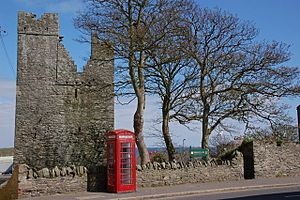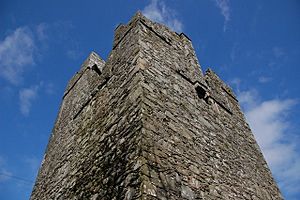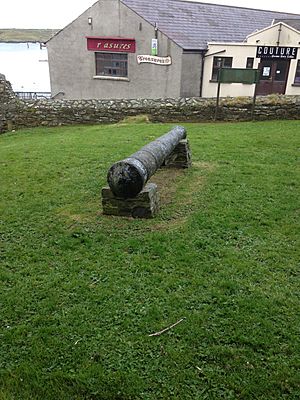Jordan's Castle facts for kids
Jordan's Castle is a historic castle located in Ardglass, County Down, Northern Ireland. It's also known by its Irish name, Caisleán MacSiurtain, and in Ulster Scots as Joardan's Kessel. This strong building is a type of castle called a tower house. It stands proudly near the harbour in Ardglass and is looked after as a State Care Historic Monument.
Contents
What Makes Jordan's Castle Special?
Jordan's Castle is a tall, rectangular tower house with four main floors. Each floor has a single room, about 20 by 13 feet in size. On its north side, there are two parts that stick out. One holds a stone spiral staircase, which is like a winding set of stairs. The other has a small, secret room on each floor. The rooms on the lower levels even have exits to the ground.
Building Materials and Design
It's hard to say exactly when the castle was built because it has been changed a lot over time. The walls are made from blue stone rubble. Some parts, like the corners and window frames, use a nicer stone called freestone. Some window designs suggest it might be from the 1400s.
The ground floor doesn't have a proper floor. You can see the uneven rock sticking out, which means it might have been used for storage. The most important room was probably on the first floor. This room still has its original stone floor, which is supported by a curved stone ceiling called a barrel vault. The floors on the second and third levels are newer, but they are at the castle's original height. The roof is also a modern addition.
Defenses and Unique Features
The top of the castle still has its stone walls for defense, called rampart walls. There are also small towers for archers to shoot from. One of these towers, in the northwest, has a special section called a dovecote. This was a place for pigeons to nest, and their nesting holes were built when the castle was first made.
The main entrance is at the bottom of the northwest tower. It leads to the spiral staircase that goes all the way to the roof. This entrance was protected by a machicolation. This is a fancy word for an opening in the floor above the entrance. Defenders could drop things like stones or hot liquids on attackers below! The two projecting towers are also connected by a high arch that works as another machicolation.
An Old Description
In 1833, a newspaper called the Dublin Penny Journal described Jordan's Castle. It said the castle was very strong and built with more style than other castles nearby. It seemed to be the main fortress in the middle of the town.
Of the remaining fortresses, the most remarkable is that called Jordan's Castle, which, though inferior in size to the King's Castle, is yet constructed with greater elegance than that, or any of the other buildings of the kind, and was a place of considerable strength. It is situated in the centre of the town, and appears to have been the citadel. This castle is memorable for the gallant defence made by its owner Simon Jordan, who, in the Tyrone rebellion, held it out for three years, till he was relieved by the Lord Deputy Mountjoy, on the 17th of June, 1601, who rewarded him for this service, both by a concordatum from the Queen and his own private bounty.
The journal also mentioned a brave man named Simon Jordan. During a time of rebellion, he defended the castle for three years! He was finally helped by a leader called Lord Deputy Mountjoy in 1601. Simon Jordan was rewarded for his loyalty and bravery.
History of Jordan's Castle
The very early history of Jordan's Castle isn't completely clear. The first definite record we have is about Simon Jordan's amazing defense of the castle. He held it against the O'Neills for three years until Lord Deputy Mountjoy came to help him in 1601. An old historian from the 1700s, named Harris, thought that someone from the Jordan family probably built the castle. This is because their family symbol, a cross and three horseshoes, is carved into a stone near the top.
Restoration and Public Use
In 1911, a collector from Belfast named Francis Joseph Bigger bought the castle. He fixed it up and used it to show his large collection of old artifacts. He wanted everyone to be able to visit and learn about Irish history. The castle also became a popular meeting place for many Irish artists and writers. Bigger was a friend and supporter to many of them.
Some friends suggested that Bigger rename the castle "Castle Seán." This was to honor Shane O'Neill, an Irish chieftain who controlled Ardglass for two years in the 1500s. They believed he might have strengthened the tower after winning a battle in 1565.
Becoming a State Monument
When Francis Joseph Bigger passed away in 1926, his relative, Dr. Joseph Bigger, gave the castle to the government. The condition was that the castle and its contents should be kept safe as an Ancient Monument. Over time, the items inside the castle were moved to other museums in Ulster. Today, the tower is no longer open for people to go inside.
Ardglass was once home to at least six castles! You can still see parts of four of them today. These include Ardglass Castle, Cowd Castle, Margaret's Castle, and of course, Jordan's Castle.




